2025秋高考英语复习基础语法专题一词法第8讲非谓语动词课件
文档属性
| 名称 | 2025秋高考英语复习基础语法专题一词法第8讲非谓语动词课件 |  | |
| 格式 | ppt | ||
| 文件大小 | 427.5KB | ||
| 资源类型 | 试卷 | ||
| 版本资源 | 通用版 | ||
| 科目 | 英语 | ||
| 更新时间 | 2025-06-09 13:03:00 | ||
图片预览

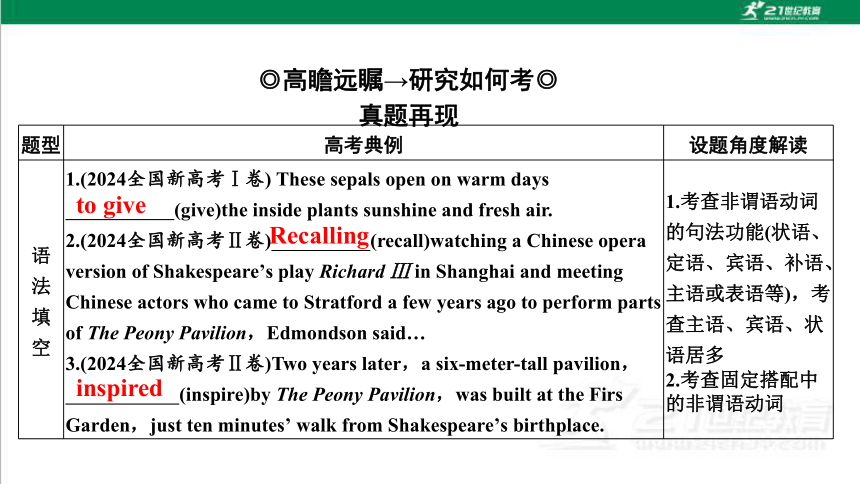
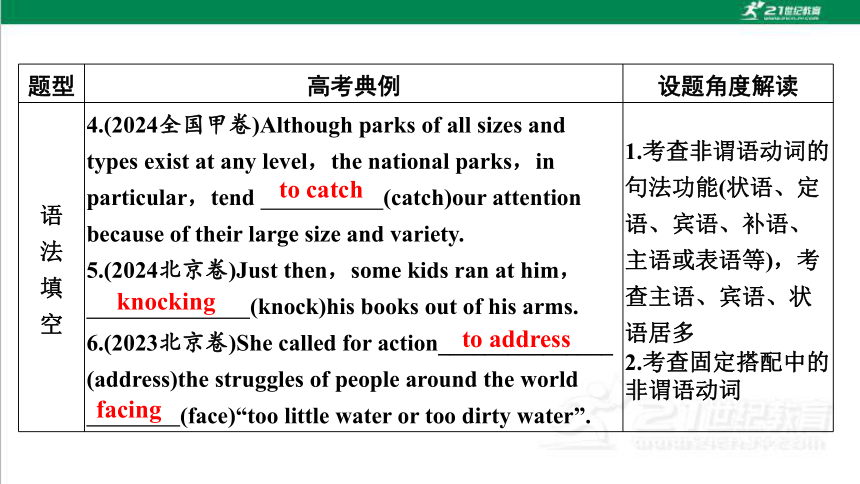
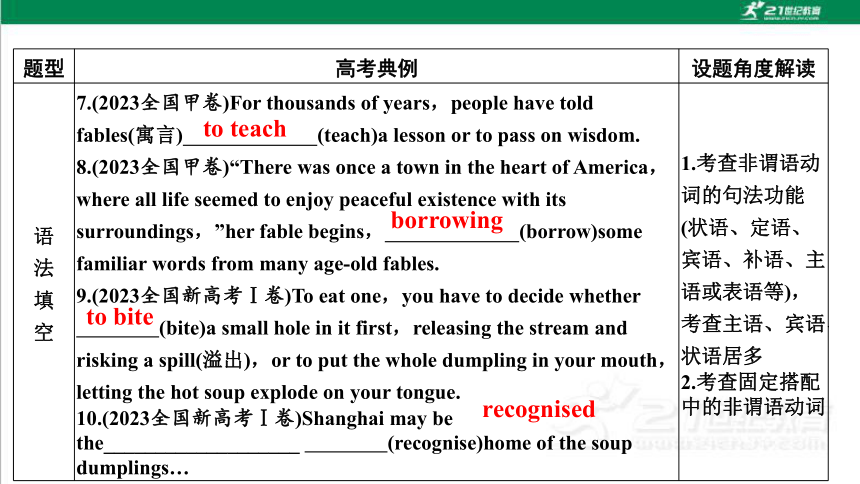

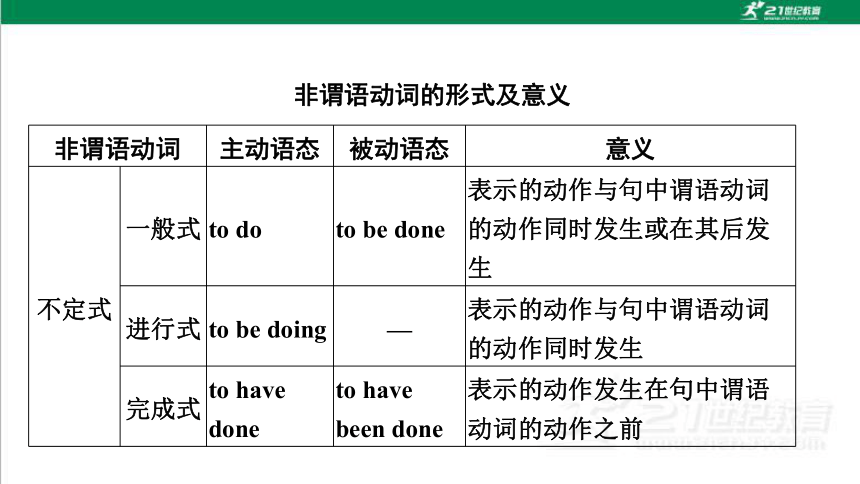
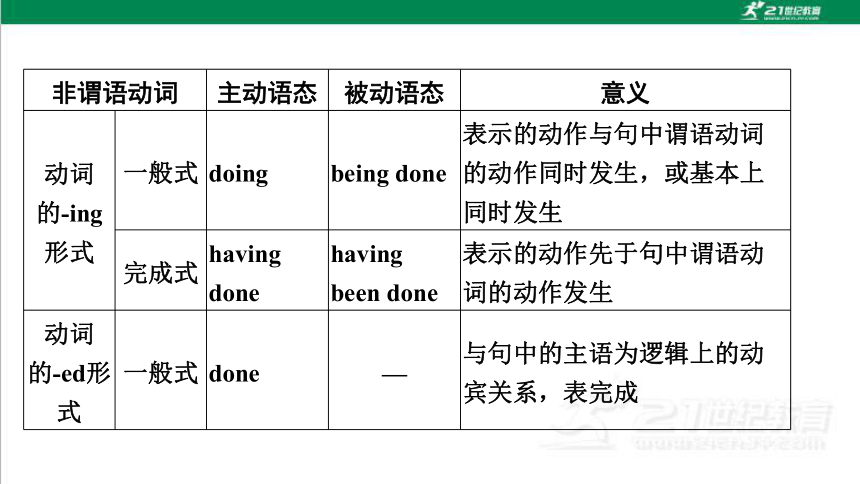

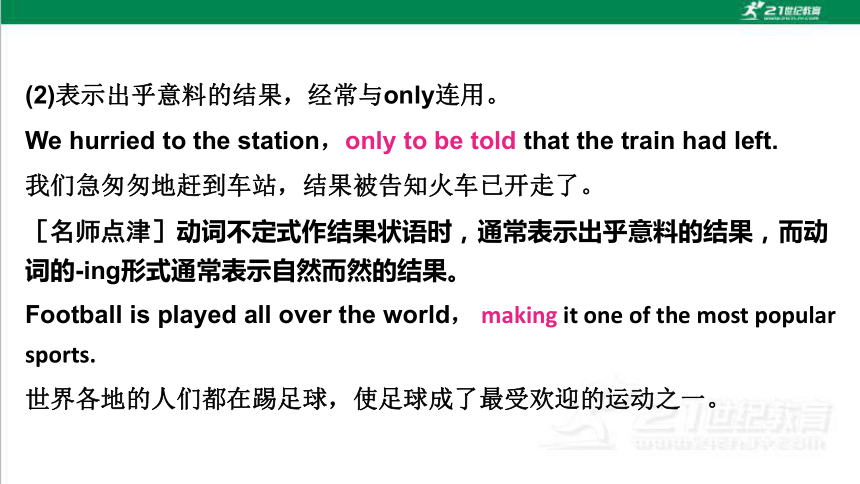

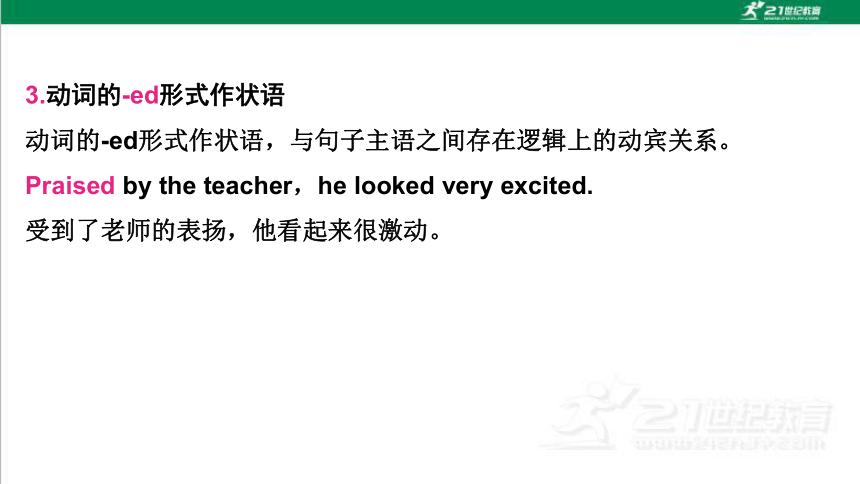

文档简介
(共41张PPT)
专题一 词法篇
第8讲 非谓语动词
◎高瞻远瞩→研究如何考◎
真题再现
题型 高考典例 设题角度解读
语
法
填
空 1.(2024全国新高考Ⅰ卷) These sepals open on warm days
(give)the inside plants sunshine and fresh air.
2.(2024全国新高考Ⅱ卷) (recall)watching a Chinese opera version of Shakespeare’s play Richard Ⅲ in Shanghai and meeting Chinese actors who came to Stratford a few years ago to perform parts of The Peony Pavilion,Edmondson said…
3.(2024全国新高考Ⅱ卷)Two years later,a six-meter-tall pavilion,
(inspire)by The Peony Pavilion,was built at the Firs Garden,just ten minutes’ walk from Shakespeare’s birthplace. 1.考查非谓语动词的句法功能(状语、定语、宾语、补语、主语或表语等),考查主语、宾语、状语居多
2.考查固定搭配中的非谓语动词
to give
Recalling
inspired
题型 高考典例 设题角度解读
语
法
填
空 4.(2024全国甲卷)Although parks of all sizes and types exist at any level,the national parks,in particular,tend (catch)our attention because of their large size and variety.
5.(2024北京卷)Just then,some kids ran at him,
(knock)his books out of his arms.
6.(2023北京卷)She called for action_______________ (address)the struggles of people around the world
(face)“too little water or too dirty water”. 1.考查非谓语动词的句法功能(状语、定语、宾语、补语、主语或表语等),考查主语、宾语、状语居多
2.考查固定搭配中的非谓语动词
to catch
knocking
to address
facing
题型 高考典例 设题角度解读
语
法
填
空 7.(2023全国甲卷)For thousands of years,people have told fables(寓言) (teach)a lesson or to pass on wisdom.
8.(2023全国甲卷)“There was once a town in the heart of America,where all life seemed to enjoy peaceful existence with its surroundings,”her fable begins, (borrow)some familiar words from many age-old fables.
9.(2023全国新高考Ⅰ卷)To eat one,you have to decide whether
(bite)a small hole in it first,releasing the stream and risking a spill(溢出),or to put the whole dumpling in your mouth,letting the hot soup explode on your tongue.
10.(2023全国新高考Ⅰ卷)Shanghai may be the___________________ (recognise)home of the soup dumplings… 1.考查非谓语动词的句法功能(状语、定语、宾语、补语、主语或表语等),考查主语、宾语、状语居多
2.考查固定搭配中的非谓语动词
to teach
borrowing
to bite
recognised
解题策略
▼若句子中已有谓语动词,且不是并列关系时,所填动词通常是非谓语动词,这时就要确定是用动词的-ing形式、动词的-ed形式,还是不定式形式。
▼所给动词在某及物动词后作宾语时通常用不定式或者动词的-ing形式(由它前面的及物动词决定);作介词的宾语时要用动词的-ing形式;作主语时要用不定式或者动词的-ing形式。如果所给动词有名词形式的派生词,当其在句中作主语或宾语时,通常考查这个动词所派生出的名词。这时,要注意它的单复数形式。
非谓语动词的形式及意义
非谓语动词 主动语态 被动语态 意义
不定式 一般式 to do to be done 表示的动作与句中谓语动词的动作同时发生或在其后发生
进行式 to be doing — 表示的动作与句中谓语动词的动作同时发生
完成式 to have done to have been done 表示的动作发生在句中谓语动词的动作之前
非谓语动词 主动语态 被动语态 意义
动词
的-ing形式 一般式 doing being done 表示的动作与句中谓语动词的动作同时发生,或基本上同时发生
完成式 having done having been done 表示的动作先于句中谓语动词的动作发生
动词
的-ed形式 一般式 done — 与句中的主语为逻辑上的动宾关系,表完成
非谓语动词作状语
1.动词不定式作状语
此时,表示目的、结果或原因等
(1)作目的状语,有时用in order to或so as to。
We will continue our campaign to prevent and control air pollution to make our sky blue again.
我们将继续我们的运动,以预防和控制空气污染,使我们的天空再次蔚蓝。
(2)表示出乎意料的结果,经常与only连用。
We hurried to the station,only to be told that the train had left.
我们急匆匆地赶到车站,结果被告知火车已开走了。
[名师点津]动词不定式作结果状语时,通常表示出乎意料的结果,而动词的-ing形式通常表示自然而然的结果。
Football is played all over the world, making it one of the most popular sports.
世界各地的人们都在踢足球,使足球成了最受欢迎的运动之一。
(3)作原因状语,此时常与表示情感的形容词连用,如glad,happy,frightened,surprised 等。
I am frightened to find that in front of my door sits a dog.
我惊恐地发现门前坐着一只狗。
2.动词的-ing形式作状语
动词-ing形式作状语,常表原因、伴随、时间、结果等,与句子主语之间存在逻辑上的主谓关系。
Like ancient sailors, birds can find their way using the sun and the stars.
像古代的水手们一样,鸟类可以利用太阳和星星找到它们的路。
3.动词的-ed形式作状语
动词的-ed形式作状语,与句子主语之间存在逻辑上的动宾关系。
Praised by the teacher,he looked very excited.
受到了老师的表扬,他看起来很激动。
4.独立主格结构
(1)构成:名词/代词+形容词/副词/介词短语/动词的-ed形式/动词-ing形式/动词不定式
(2)特点:①独立主格结构的逻辑主语与句子的主语不同,它独立存在;②独立主格结构中作逻辑主语的名词或代词与后面的动词是逻辑上的主谓或动宾关系; ③它表示谓语动作发生的时间、原因、条件或伴随情况等,相当于一个状语从句或并列句。
The work done(=After the work had been done), we went home.
工作完成后,我们就回家了。
Weather permitting(=If weather permits),they will go on an outing to the beach tomorrow.
如果天气允许的话,他们明天将去海边郊游。
He is lying on the grass, his hands crossed under his head(=and his hands were crossed under his head).
他正躺在草地上,双手交叉放在头下。
非谓语动词作定语
1.动词不定式作定语
(1)动词不定式作定语,通常置于所修饰的名词或代词之后,与所修饰的词之间构成逻辑上的主谓或动宾关系。
I can’t think of any good advice to give her.
我想不出任何好的建议给她。
(2)当名词或代词被序数词,形容词最高级,the last, the only等修饰,且动词不定式与其逻辑主语为主谓关系时,常用动词不定式作定语。
He is always the first to arrive at the school and the last to leave the school.
他总是第一个到校,最后一个离校。
(3)当被修饰词是表示抽象意义的名词时,常用动词不定式作后置定语且动词不定式常用主动形式,常见的此类名词有ability,chance, idea, plan, way, opportunity等。
The ability to express an idea is as important as the idea itself.
表达观点的能力与观点本身同等重要。
[名师点津]在作定语的动词不定式中,如果该动词为不及物动词,其后不能省略已有的介词。
2.动词的-ing形式作定语
当动词与被修饰的名词之间为主谓关系或用来表示正在进行的动作时,用动词-ing 形式。
The lecture,starting at 7:00 p.m.last night,was followed by an observation of the moon with telescopes.
这次演讲开始于昨天晚上7点,紧接着是用望远镜观看月球的活动。
[名师点津]被修饰的名词与动词之间为动宾关系且表示正在进行时,应用being done作定语。
3.动词的-ed形式作定语
动词的-ed形式作定语,与被修饰的名词之间是逻辑上的动宾关系。
I’d like you to look at a study conducted in Australia last year.
我想让你们看看去年在澳大利亚进行的一项研究。
◎核心精讲→归纳如何学◎
非谓语动词作宾语补足语
1.see, watch, observe, notice, look at, hear, listen to, feel后面宾语补足语常见的非谓语动词形式有三种:do, doing或done。do表示主动和完成(被动句中动词不定式符号to要还原),doing表示主动或正在进行,done 表示被动或完成。
The missing boy was last seen playing near the river.
失踪的小男孩最后一次被看到时正在河边玩耍。
2.使役动词let, make, have, get, leave, keep等后接非谓语动词作宾语补足语。
On the contrary,those who let teenagers experience the consequences of their actions can do better.
相反,那些让青少年体会了他们行为后果的人能够做得更优秀。
3.常跟动词不定式作宾语补足语的动词有tell, ask, advise, allow, encourage, request, warn等。
My teacher encouraged me to believe I could do anything.
我的老师鼓励我要相信自己能行。
4.with/without的复合结构为“with/without+名词或代词+doing(表主动、进行)/done(表被动、完成)/to do(表目的、将来)”。
I am walking alone in the park, with my little dog following me.
我独自在公园里散步,我的小狗跟在我后面。
非谓语动词作主语、宾语或表语
1.非谓语动词中能作主语的有动词的-ing形式和动词不定式
(1)动词的-ing形式作主语表示一般的、抽象的或习惯性的动作,而动词不定式作主语表示具体的、一次性的或尚未发生的动作。
Dancing and skating are my hobbies.
跳舞和溜冰都是我的爱好。
To complete the programme needs much effort.
要完成这个项目需要很多努力。
(2)it作形式主语,代替真正作主语的动词不定式(短语)或动词-ing形式(短语)。
常见的句型有:It is/was no use/good doing sth.;It is/was not any use/good doing sth.;It is/was of little use/good doing sth.; It is/was useless doing sth.; It’s a waste of time doing sth.; It is easy/important/vital/necessary/difficult to do sth.等。
It is no use trying to persuade such a stubborn person.
要说服这样一个固执的人是没有什么用处的。
2.非谓语动词中能作宾语的有动词的-ing形式和动词不定式
(1)只能跟动词的-ing形式作宾语的动词(短语)
喜欢考虑逃避免(enjoy,consider,escape,avoid);不禁放弃太冒险(cannot help,give up,risk);感激承认很值得(appreciate,admit,worth);介意想象莫推延(mind,imagine,delay,put off);允许完成及期望(allow/permit,finish,look forward to);建议继续勤练习(suggest,go on,practise);致力原谅要坚持(be devoted to,excuse,insist on);继续成功不错过(keep on,succeed in,miss)。
They avoid going out alone after dark.
他们避免黄昏后独自出门。
(2)只能跟动词不定式作宾语的动词(短语)
三个希望两答应(hope,wish,expect,agree,promise);两个要求莫拒绝(demand,ask,refuse);设法学会做决定(manage,learn,decide/determine);不要假装在选择(pretend,choose/select);打算提出俩计划(intend/mean,offer,plan);申请失败负担起(apply,fail,afford);准备愿望又碰巧(prepare,desire,happen)。
At the same time, I decided to study harder rather than waste precious time on those useless things.
与此同时,我决定更努力地学习,而不是浪费宝贵的时间在那些无用的东西上。
[名师点津]
①动词want,need,require作“需要”讲时,其后可用动词的-ing形式的主动语态或动词不定式的被动式作宾语。与此用法相同的动词还有deserve(值得)。
②动词不定式作动词(短语)learn,decide,know,wonder,show,tell,understand,explain,teach,advise,find out 等的宾语时,其前可加引导词how,what,who,whether,where,when等。
(3)既可跟动词的-ing形式又可跟动词不定式的动词和短语但意义不相同的有:go on,remember,forget,regret,stop,mean,start,begin,try等。
I mean to go, but my father would not allow me to.
我想去,但是我的父亲不让我去。
To raise wage means increasing purchasing power.
提高工资意味着增加购买力。
3.非谓语动词中能作表语的有动词的-ing形式、动词的-ed形式和动词不定式
动词的-ing形式作表语时,意为“令人感到……的”;动词的-ed形式作表语时,意为“感到……的”;动词不定式作表语,可以说明主语的具体内容或表目的。
The story sounds interesting.
这个故事听起来很有趣。
She was exhausted.
她筋疲力尽了。
My job is to feed animals.
我的工作是饲养动物。
◎冲关训练→专练如何解◎
Ⅰ.单句语法填空
1.(2024浙江1月卷)Over the last two years, some supermarkets have started selling chicken or salad in packs (design) with two halves containing separate portions(份).
2.(2023全国新高考Ⅰ卷)No matter where I buy them, one steamer is rarely enough, yet two seems greedy, so I am always left (want) more next time.
designed
wanting
1.考查动词的-ed形式。句意:在过去的两年里,一些超市开始销售鸡肉或沙拉包装,设计成两半,拆分成两份。分析句子结构可知,空格处所在句子已有谓语“have started”,故用非谓语动词形式。动词design与其逻辑主语packs为动宾关系,应用动词的-ed形式作后置定语。故填designed。
2. 考查动词的-ing形式。句意:无论我在哪里买,一蒸笼都不够,而两蒸笼又显得太贪心了,所以我下次总是想买更多。分析句子结构可知,此处考查“leave sb.+宾语补足语”结构,动词want与其逻辑主语I为主谓关系,应用动词的-ing形式。故填wanting。
3.(2023全国乙卷)From Buddhist temples to museums, narrow hutong to royal palaces, it is home to more than 3,000 years of glorious history even down to its layout, with the city keeping its carefully (build) system of ring roads.
4.(2023全国乙卷) (visit)several times over the last 10 years, I was amazed by the co-existence of old and new, and how a city was able to keep such a rich heritage(遗产) while constantly growing.
5.(2022北京卷)One theory, increasingly (support) by experts, suggests that smell preferences are learned.
built
Having visited
supported
3. 考查动词的-ed形式。句意:从佛教寺庙到博物馆,狭窄的胡同和皇家宫殿,它是3000多年辉煌历史的家园,即使是在它的布局上,这座城市也保持着精心建造的环城公路系统。此处修饰名词短语“system of ring roads”,且两者之间为逻辑上的动宾关系,应用动词的-ed形式作前置主语。故填built。
4. 考查动词的-ing形式。句意:在过去的10年里,我多次访问北京,我惊讶于这里的新旧共存,惊讶于一个城市如何在不断发展的同时保持如此丰富的文化遗产。分析句子结构可知,空格处所在句子已有谓语was,故用非谓语动词形式。动词visit与其逻辑主语I为主谓关系,再根据时间状语“over the last 10 years”可知,此处应用动词的-ing形式的完成式作状语。此处位于句首,首字母应大写。故填Having visited。
6.(2022全国甲卷)A visually-challenged man from Beijing recently hiked 40 days to Xi’an, as a first step (journey) the Belt and Road route(路线) by foot.
7.(2022全国甲卷)Inspired by the Belt and Road Forum for International Cooperation (hold) in Beijing, Cao decided to cover the route by hiking as a tribute(致敬) to the ancient Silk Road.
8.(2022全国乙卷)“It can help to build a community with a (share) future for mankind,” he said.
to journey
held
shared
5. 考查动词的-ed形式。句意:一个越来越受到专家支持的理论表明气味的偏好是习得的。分析句子结构可知,空格处所在句子已有谓语suggests,再结合空格后的“by experts”可知,此处应用动词的-ed形式。故填supported。
6. 考查动词不定式。句意:近日,一名来自北京的盲人徒步40天来到西安,作为“一带一路”徒步旅行的第一步。分析句子结构并结合语境可知,journey作动词,表示“旅行”;step前面有序数词,应用不定式作后置定语。故填to journey。
7. 考查动词的-ed形式。句意:受到在北京举行的“一带一路”国际合作高峰论坛的启发,曹决定徒步穿越这条路线,以向古代丝绸之路致敬。分析句子结构可知,本句已有谓语decided,故用非谓语动词形式。动词hold与其逻辑主语“the Belt and Road Forum for International Cooperation”为动宾关系,应用动词的-ed形式作后置定语。故填held。
8.考查动词的-ed形式。句意:他说:“这有助于构建人类命运共同体”。此处修饰名词future,且两者之间为逻辑上的动宾关系,应用动词的-ed形式作前置定语。故填shared。
9.(2022全国乙卷) (strengthen) the connection with young people, the event included a number of public promotional activities on social media, (invite) twenty-nine tea professionals from around the world to have thirty-six hours of uninterrupted live broadcasts.
10.(2022全国新高考Ⅱ卷)Henry ran one hundred metres, jumped over a 1.2-metre fence, and held out his arms to catch the (fall) child.
To strengthen
inviting
alling
9.; 考查动词不定式和动词的-ing形式。句意:为了加强与年轻人的联系,此次活动包括社交媒体上的一系列公共宣传活动,邀请了来自世界各地的29名茶叶专业人士进行36小时不间断的直播。分析句子结构可知,空格处所在句子已有谓语included,故用非谓语动词形式。第一个空格表示活动目的,应用动词不定式作目的状语;第二个空格的动词invite与其逻辑主语“the event”为主谓关系,应用动词的-ing形式。故填To strengthen; inviting。
10.考查动词的-ing形式。句意:Henry跑了100米,跳过了一个1.2米高的栅栏,伸出双臂去接要掉下来的孩子。分析句子结构可知,空格处所在句子已有谓语“held out”,故用非谓语动词形式。再根据语境可知,动词fall与其逻辑主语child为主谓关系且表示正在进行,应用动词的-ing形式作定语。故填falling。
Ⅱ.语法填空
Volunteer travel, also 1. (know) as voluntourism, refers to taking a trip whose purpose is to participate in an arranged service opportunity 2. (give) back to the local community and make a difference. Volunteer travel dates back to the 1960s, when Alec Dickson and his wife Mora from the UK founded Voluntary Service Overseas(VSO), an international volunteer organisation. Various activities 3. (range) from conservation work to education and healthcare projects can be involved in volunteer travel. These projects are typically organised by
known
to give
ranging
nonprofit organisations or travel agencies that specialise in responsible and sustainable tourism.
Volunteer travel can help 4. (address) social and environmental issues, contribute to local development projects and help with disaster relief efforts.5. (work) voluntarily while exploring new destinations and cultures allows individuals6. (learn) new skills and gain a deeper 7. (understand) of a country and its people.
(to)address
Working
to learn
understanding
Volunteer travel in rural areas is now attracting more urban visitors as a break from the fast and stressful pace of urban living. It has indeed been a
8. (grow) trend for urban residents 9. (volunteer) in rural areas. For those who are sick of urban pressure but can’t decide whether 10. (move) to the countryside, volunteer travel can be an alternative solution.
growing
to volunteer
to move
专题一 词法篇
第8讲 非谓语动词
◎高瞻远瞩→研究如何考◎
真题再现
题型 高考典例 设题角度解读
语
法
填
空 1.(2024全国新高考Ⅰ卷) These sepals open on warm days
(give)the inside plants sunshine and fresh air.
2.(2024全国新高考Ⅱ卷) (recall)watching a Chinese opera version of Shakespeare’s play Richard Ⅲ in Shanghai and meeting Chinese actors who came to Stratford a few years ago to perform parts of The Peony Pavilion,Edmondson said…
3.(2024全国新高考Ⅱ卷)Two years later,a six-meter-tall pavilion,
(inspire)by The Peony Pavilion,was built at the Firs Garden,just ten minutes’ walk from Shakespeare’s birthplace. 1.考查非谓语动词的句法功能(状语、定语、宾语、补语、主语或表语等),考查主语、宾语、状语居多
2.考查固定搭配中的非谓语动词
to give
Recalling
inspired
题型 高考典例 设题角度解读
语
法
填
空 4.(2024全国甲卷)Although parks of all sizes and types exist at any level,the national parks,in particular,tend (catch)our attention because of their large size and variety.
5.(2024北京卷)Just then,some kids ran at him,
(knock)his books out of his arms.
6.(2023北京卷)She called for action_______________ (address)the struggles of people around the world
(face)“too little water or too dirty water”. 1.考查非谓语动词的句法功能(状语、定语、宾语、补语、主语或表语等),考查主语、宾语、状语居多
2.考查固定搭配中的非谓语动词
to catch
knocking
to address
facing
题型 高考典例 设题角度解读
语
法
填
空 7.(2023全国甲卷)For thousands of years,people have told fables(寓言) (teach)a lesson or to pass on wisdom.
8.(2023全国甲卷)“There was once a town in the heart of America,where all life seemed to enjoy peaceful existence with its surroundings,”her fable begins, (borrow)some familiar words from many age-old fables.
9.(2023全国新高考Ⅰ卷)To eat one,you have to decide whether
(bite)a small hole in it first,releasing the stream and risking a spill(溢出),or to put the whole dumpling in your mouth,letting the hot soup explode on your tongue.
10.(2023全国新高考Ⅰ卷)Shanghai may be the___________________ (recognise)home of the soup dumplings… 1.考查非谓语动词的句法功能(状语、定语、宾语、补语、主语或表语等),考查主语、宾语、状语居多
2.考查固定搭配中的非谓语动词
to teach
borrowing
to bite
recognised
解题策略
▼若句子中已有谓语动词,且不是并列关系时,所填动词通常是非谓语动词,这时就要确定是用动词的-ing形式、动词的-ed形式,还是不定式形式。
▼所给动词在某及物动词后作宾语时通常用不定式或者动词的-ing形式(由它前面的及物动词决定);作介词的宾语时要用动词的-ing形式;作主语时要用不定式或者动词的-ing形式。如果所给动词有名词形式的派生词,当其在句中作主语或宾语时,通常考查这个动词所派生出的名词。这时,要注意它的单复数形式。
非谓语动词的形式及意义
非谓语动词 主动语态 被动语态 意义
不定式 一般式 to do to be done 表示的动作与句中谓语动词的动作同时发生或在其后发生
进行式 to be doing — 表示的动作与句中谓语动词的动作同时发生
完成式 to have done to have been done 表示的动作发生在句中谓语动词的动作之前
非谓语动词 主动语态 被动语态 意义
动词
的-ing形式 一般式 doing being done 表示的动作与句中谓语动词的动作同时发生,或基本上同时发生
完成式 having done having been done 表示的动作先于句中谓语动词的动作发生
动词
的-ed形式 一般式 done — 与句中的主语为逻辑上的动宾关系,表完成
非谓语动词作状语
1.动词不定式作状语
此时,表示目的、结果或原因等
(1)作目的状语,有时用in order to或so as to。
We will continue our campaign to prevent and control air pollution to make our sky blue again.
我们将继续我们的运动,以预防和控制空气污染,使我们的天空再次蔚蓝。
(2)表示出乎意料的结果,经常与only连用。
We hurried to the station,only to be told that the train had left.
我们急匆匆地赶到车站,结果被告知火车已开走了。
[名师点津]动词不定式作结果状语时,通常表示出乎意料的结果,而动词的-ing形式通常表示自然而然的结果。
Football is played all over the world, making it one of the most popular sports.
世界各地的人们都在踢足球,使足球成了最受欢迎的运动之一。
(3)作原因状语,此时常与表示情感的形容词连用,如glad,happy,frightened,surprised 等。
I am frightened to find that in front of my door sits a dog.
我惊恐地发现门前坐着一只狗。
2.动词的-ing形式作状语
动词-ing形式作状语,常表原因、伴随、时间、结果等,与句子主语之间存在逻辑上的主谓关系。
Like ancient sailors, birds can find their way using the sun and the stars.
像古代的水手们一样,鸟类可以利用太阳和星星找到它们的路。
3.动词的-ed形式作状语
动词的-ed形式作状语,与句子主语之间存在逻辑上的动宾关系。
Praised by the teacher,he looked very excited.
受到了老师的表扬,他看起来很激动。
4.独立主格结构
(1)构成:名词/代词+形容词/副词/介词短语/动词的-ed形式/动词-ing形式/动词不定式
(2)特点:①独立主格结构的逻辑主语与句子的主语不同,它独立存在;②独立主格结构中作逻辑主语的名词或代词与后面的动词是逻辑上的主谓或动宾关系; ③它表示谓语动作发生的时间、原因、条件或伴随情况等,相当于一个状语从句或并列句。
The work done(=After the work had been done), we went home.
工作完成后,我们就回家了。
Weather permitting(=If weather permits),they will go on an outing to the beach tomorrow.
如果天气允许的话,他们明天将去海边郊游。
He is lying on the grass, his hands crossed under his head(=and his hands were crossed under his head).
他正躺在草地上,双手交叉放在头下。
非谓语动词作定语
1.动词不定式作定语
(1)动词不定式作定语,通常置于所修饰的名词或代词之后,与所修饰的词之间构成逻辑上的主谓或动宾关系。
I can’t think of any good advice to give her.
我想不出任何好的建议给她。
(2)当名词或代词被序数词,形容词最高级,the last, the only等修饰,且动词不定式与其逻辑主语为主谓关系时,常用动词不定式作定语。
He is always the first to arrive at the school and the last to leave the school.
他总是第一个到校,最后一个离校。
(3)当被修饰词是表示抽象意义的名词时,常用动词不定式作后置定语且动词不定式常用主动形式,常见的此类名词有ability,chance, idea, plan, way, opportunity等。
The ability to express an idea is as important as the idea itself.
表达观点的能力与观点本身同等重要。
[名师点津]在作定语的动词不定式中,如果该动词为不及物动词,其后不能省略已有的介词。
2.动词的-ing形式作定语
当动词与被修饰的名词之间为主谓关系或用来表示正在进行的动作时,用动词-ing 形式。
The lecture,starting at 7:00 p.m.last night,was followed by an observation of the moon with telescopes.
这次演讲开始于昨天晚上7点,紧接着是用望远镜观看月球的活动。
[名师点津]被修饰的名词与动词之间为动宾关系且表示正在进行时,应用being done作定语。
3.动词的-ed形式作定语
动词的-ed形式作定语,与被修饰的名词之间是逻辑上的动宾关系。
I’d like you to look at a study conducted in Australia last year.
我想让你们看看去年在澳大利亚进行的一项研究。
◎核心精讲→归纳如何学◎
非谓语动词作宾语补足语
1.see, watch, observe, notice, look at, hear, listen to, feel后面宾语补足语常见的非谓语动词形式有三种:do, doing或done。do表示主动和完成(被动句中动词不定式符号to要还原),doing表示主动或正在进行,done 表示被动或完成。
The missing boy was last seen playing near the river.
失踪的小男孩最后一次被看到时正在河边玩耍。
2.使役动词let, make, have, get, leave, keep等后接非谓语动词作宾语补足语。
On the contrary,those who let teenagers experience the consequences of their actions can do better.
相反,那些让青少年体会了他们行为后果的人能够做得更优秀。
3.常跟动词不定式作宾语补足语的动词有tell, ask, advise, allow, encourage, request, warn等。
My teacher encouraged me to believe I could do anything.
我的老师鼓励我要相信自己能行。
4.with/without的复合结构为“with/without+名词或代词+doing(表主动、进行)/done(表被动、完成)/to do(表目的、将来)”。
I am walking alone in the park, with my little dog following me.
我独自在公园里散步,我的小狗跟在我后面。
非谓语动词作主语、宾语或表语
1.非谓语动词中能作主语的有动词的-ing形式和动词不定式
(1)动词的-ing形式作主语表示一般的、抽象的或习惯性的动作,而动词不定式作主语表示具体的、一次性的或尚未发生的动作。
Dancing and skating are my hobbies.
跳舞和溜冰都是我的爱好。
To complete the programme needs much effort.
要完成这个项目需要很多努力。
(2)it作形式主语,代替真正作主语的动词不定式(短语)或动词-ing形式(短语)。
常见的句型有:It is/was no use/good doing sth.;It is/was not any use/good doing sth.;It is/was of little use/good doing sth.; It is/was useless doing sth.; It’s a waste of time doing sth.; It is easy/important/vital/necessary/difficult to do sth.等。
It is no use trying to persuade such a stubborn person.
要说服这样一个固执的人是没有什么用处的。
2.非谓语动词中能作宾语的有动词的-ing形式和动词不定式
(1)只能跟动词的-ing形式作宾语的动词(短语)
喜欢考虑逃避免(enjoy,consider,escape,avoid);不禁放弃太冒险(cannot help,give up,risk);感激承认很值得(appreciate,admit,worth);介意想象莫推延(mind,imagine,delay,put off);允许完成及期望(allow/permit,finish,look forward to);建议继续勤练习(suggest,go on,practise);致力原谅要坚持(be devoted to,excuse,insist on);继续成功不错过(keep on,succeed in,miss)。
They avoid going out alone after dark.
他们避免黄昏后独自出门。
(2)只能跟动词不定式作宾语的动词(短语)
三个希望两答应(hope,wish,expect,agree,promise);两个要求莫拒绝(demand,ask,refuse);设法学会做决定(manage,learn,decide/determine);不要假装在选择(pretend,choose/select);打算提出俩计划(intend/mean,offer,plan);申请失败负担起(apply,fail,afford);准备愿望又碰巧(prepare,desire,happen)。
At the same time, I decided to study harder rather than waste precious time on those useless things.
与此同时,我决定更努力地学习,而不是浪费宝贵的时间在那些无用的东西上。
[名师点津]
①动词want,need,require作“需要”讲时,其后可用动词的-ing形式的主动语态或动词不定式的被动式作宾语。与此用法相同的动词还有deserve(值得)。
②动词不定式作动词(短语)learn,decide,know,wonder,show,tell,understand,explain,teach,advise,find out 等的宾语时,其前可加引导词how,what,who,whether,where,when等。
(3)既可跟动词的-ing形式又可跟动词不定式的动词和短语但意义不相同的有:go on,remember,forget,regret,stop,mean,start,begin,try等。
I mean to go, but my father would not allow me to.
我想去,但是我的父亲不让我去。
To raise wage means increasing purchasing power.
提高工资意味着增加购买力。
3.非谓语动词中能作表语的有动词的-ing形式、动词的-ed形式和动词不定式
动词的-ing形式作表语时,意为“令人感到……的”;动词的-ed形式作表语时,意为“感到……的”;动词不定式作表语,可以说明主语的具体内容或表目的。
The story sounds interesting.
这个故事听起来很有趣。
She was exhausted.
她筋疲力尽了。
My job is to feed animals.
我的工作是饲养动物。
◎冲关训练→专练如何解◎
Ⅰ.单句语法填空
1.(2024浙江1月卷)Over the last two years, some supermarkets have started selling chicken or salad in packs (design) with two halves containing separate portions(份).
2.(2023全国新高考Ⅰ卷)No matter where I buy them, one steamer is rarely enough, yet two seems greedy, so I am always left (want) more next time.
designed
wanting
1.考查动词的-ed形式。句意:在过去的两年里,一些超市开始销售鸡肉或沙拉包装,设计成两半,拆分成两份。分析句子结构可知,空格处所在句子已有谓语“have started”,故用非谓语动词形式。动词design与其逻辑主语packs为动宾关系,应用动词的-ed形式作后置定语。故填designed。
2. 考查动词的-ing形式。句意:无论我在哪里买,一蒸笼都不够,而两蒸笼又显得太贪心了,所以我下次总是想买更多。分析句子结构可知,此处考查“leave sb.+宾语补足语”结构,动词want与其逻辑主语I为主谓关系,应用动词的-ing形式。故填wanting。
3.(2023全国乙卷)From Buddhist temples to museums, narrow hutong to royal palaces, it is home to more than 3,000 years of glorious history even down to its layout, with the city keeping its carefully (build) system of ring roads.
4.(2023全国乙卷) (visit)several times over the last 10 years, I was amazed by the co-existence of old and new, and how a city was able to keep such a rich heritage(遗产) while constantly growing.
5.(2022北京卷)One theory, increasingly (support) by experts, suggests that smell preferences are learned.
built
Having visited
supported
3. 考查动词的-ed形式。句意:从佛教寺庙到博物馆,狭窄的胡同和皇家宫殿,它是3000多年辉煌历史的家园,即使是在它的布局上,这座城市也保持着精心建造的环城公路系统。此处修饰名词短语“system of ring roads”,且两者之间为逻辑上的动宾关系,应用动词的-ed形式作前置主语。故填built。
4. 考查动词的-ing形式。句意:在过去的10年里,我多次访问北京,我惊讶于这里的新旧共存,惊讶于一个城市如何在不断发展的同时保持如此丰富的文化遗产。分析句子结构可知,空格处所在句子已有谓语was,故用非谓语动词形式。动词visit与其逻辑主语I为主谓关系,再根据时间状语“over the last 10 years”可知,此处应用动词的-ing形式的完成式作状语。此处位于句首,首字母应大写。故填Having visited。
6.(2022全国甲卷)A visually-challenged man from Beijing recently hiked 40 days to Xi’an, as a first step (journey) the Belt and Road route(路线) by foot.
7.(2022全国甲卷)Inspired by the Belt and Road Forum for International Cooperation (hold) in Beijing, Cao decided to cover the route by hiking as a tribute(致敬) to the ancient Silk Road.
8.(2022全国乙卷)“It can help to build a community with a (share) future for mankind,” he said.
to journey
held
shared
5. 考查动词的-ed形式。句意:一个越来越受到专家支持的理论表明气味的偏好是习得的。分析句子结构可知,空格处所在句子已有谓语suggests,再结合空格后的“by experts”可知,此处应用动词的-ed形式。故填supported。
6. 考查动词不定式。句意:近日,一名来自北京的盲人徒步40天来到西安,作为“一带一路”徒步旅行的第一步。分析句子结构并结合语境可知,journey作动词,表示“旅行”;step前面有序数词,应用不定式作后置定语。故填to journey。
7. 考查动词的-ed形式。句意:受到在北京举行的“一带一路”国际合作高峰论坛的启发,曹决定徒步穿越这条路线,以向古代丝绸之路致敬。分析句子结构可知,本句已有谓语decided,故用非谓语动词形式。动词hold与其逻辑主语“the Belt and Road Forum for International Cooperation”为动宾关系,应用动词的-ed形式作后置定语。故填held。
8.考查动词的-ed形式。句意:他说:“这有助于构建人类命运共同体”。此处修饰名词future,且两者之间为逻辑上的动宾关系,应用动词的-ed形式作前置定语。故填shared。
9.(2022全国乙卷) (strengthen) the connection with young people, the event included a number of public promotional activities on social media, (invite) twenty-nine tea professionals from around the world to have thirty-six hours of uninterrupted live broadcasts.
10.(2022全国新高考Ⅱ卷)Henry ran one hundred metres, jumped over a 1.2-metre fence, and held out his arms to catch the (fall) child.
To strengthen
inviting
alling
9.; 考查动词不定式和动词的-ing形式。句意:为了加强与年轻人的联系,此次活动包括社交媒体上的一系列公共宣传活动,邀请了来自世界各地的29名茶叶专业人士进行36小时不间断的直播。分析句子结构可知,空格处所在句子已有谓语included,故用非谓语动词形式。第一个空格表示活动目的,应用动词不定式作目的状语;第二个空格的动词invite与其逻辑主语“the event”为主谓关系,应用动词的-ing形式。故填To strengthen; inviting。
10.考查动词的-ing形式。句意:Henry跑了100米,跳过了一个1.2米高的栅栏,伸出双臂去接要掉下来的孩子。分析句子结构可知,空格处所在句子已有谓语“held out”,故用非谓语动词形式。再根据语境可知,动词fall与其逻辑主语child为主谓关系且表示正在进行,应用动词的-ing形式作定语。故填falling。
Ⅱ.语法填空
Volunteer travel, also 1. (know) as voluntourism, refers to taking a trip whose purpose is to participate in an arranged service opportunity 2. (give) back to the local community and make a difference. Volunteer travel dates back to the 1960s, when Alec Dickson and his wife Mora from the UK founded Voluntary Service Overseas(VSO), an international volunteer organisation. Various activities 3. (range) from conservation work to education and healthcare projects can be involved in volunteer travel. These projects are typically organised by
known
to give
ranging
nonprofit organisations or travel agencies that specialise in responsible and sustainable tourism.
Volunteer travel can help 4. (address) social and environmental issues, contribute to local development projects and help with disaster relief efforts.5. (work) voluntarily while exploring new destinations and cultures allows individuals6. (learn) new skills and gain a deeper 7. (understand) of a country and its people.
(to)address
Working
to learn
understanding
Volunteer travel in rural areas is now attracting more urban visitors as a break from the fast and stressful pace of urban living. It has indeed been a
8. (grow) trend for urban residents 9. (volunteer) in rural areas. For those who are sick of urban pressure but can’t decide whether 10. (move) to the countryside, volunteer travel can be an alternative solution.
growing
to volunteer
to move
